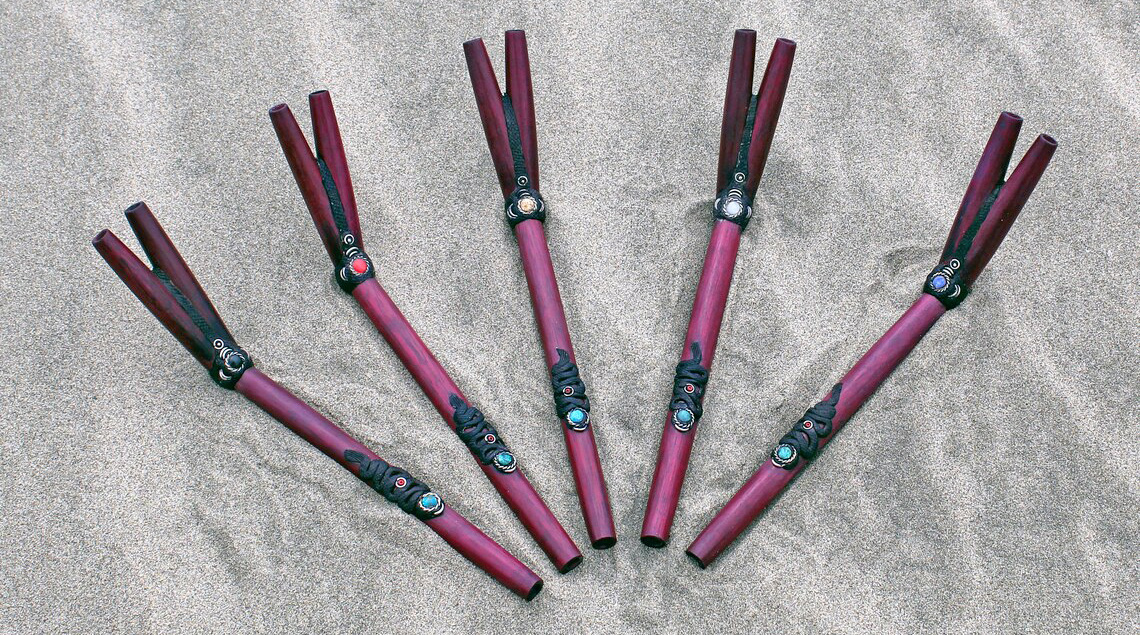How to Use Tepi Applicator During Ceremonies?

The tepi applicator, used in traditional ceremonies, is a tool to administer rapé (pronounced “ha-peh”), a sacred plant medicine made from powdered tobacco and other herbs. Here’s a step-by-step guide on using it ceremonially:
1. Intentional Grounding Practices for Giver and Receiver
- Energetic Clearing Before Starting: Both the giver and receiver may take a few minutes before the ceremony to cleanse their energy fields. This can involve brushing their hands over their body or visualizing a purifying light to release any energies that may interfere with the ceremony.
- Grounding Elements: It’s beneficial for both participants to physically ground themselves by sitting directly on the earth if outdoors, or by placing a grounding object (such as a crystal, feather, or stone) on their lap to help maintain connection to the earth.
2. Setting a Strong Sacred Container and Intentions Together
- Creating a Ritual Circle: Some ceremonies begin by symbolically setting a boundary, either by sitting in a circle of natural elements (such as stones, leaves, or flower petals) or by verbally acknowledging that the space is now sacred. This practice, especially in groups, helps bring everyone into a focused mindset.
- Shared Intentions: The giver may lead the receiver in a brief meditation or a simple spoken intention. Sometimes, the giver speaks a blessing over the rapé powder itself, asking for guidance, healing, or clarity to be delivered through the medicine.
3. Sacred Handling of the Rapé and the Tepi Aplicator
- Handling the Medicine with Respect: In traditional practice, the rapé is seen as a sacred plant medicine, so the giver and receiver approach it reverently. Many will avoid touching it unnecessarily and hold it with both hands while making eye contact, as a form of “introducing” themselves to the medicine.
- Mindful Loading of the Tepi Applicator: Loading the rapé into the tepi applicator is done with focus. Some people will briefly hold the applicator to their forehead or heart, silently conveying the intention to the medicine. The amount of rapé is carefully considered for the receiver’s experience level, as different types and doses can have very different effects.
4. Ceremonial Posture, Breathwork, and Attunement During Administration
- Aligned Posture and Open Hands: The receiver sits with an upright posture, open hands resting on the thighs, palms up, signifying openness and readiness to receive. If they’re able, they may close their eyes and breathe deeply as they prepare to receive the rapé.
- Breath and Attention: Before each blow, both giver and receiver take a few deep breaths together, synchronizing in preparation. The giver may take one deep breath in, and the receiver exhales fully to relax before the medicine enters. Focusing on breathwork helps both enter a shared rhythm, enhancing connection.
- Strength and Rhythm of the Blow: The blow is steady, intentional, and rhythmic, not rushed. Experienced practitioners often say a quiet prayer or set an intention silently before each blow to bless and strengthen the effect of the medicine.
5. Guided Support and Observation During Integration
- Immediate Integration and Release: Right after receiving, the receiver may experience sensations like heat, tingling, or pressure in the head or body. The giver often remains silent but watchful, offering subtle encouragement to relax and accept these sensations.
- Physical and Emotional Release: Rapé sometimes triggers physical cleansing or emotional release, and participants may cough, tear up, or have spontaneous body movements. These are all seen as natural responses to the medicine’s effects, and the giver may gently remind the receiver to stay open to whatever comes up, supporting their process.
- Assisting with Grounding if Needed: If the receiver seems overwhelmed, the giver can guide them to place a hand on their heart or belly to feel grounded or to visualize roots connecting them to the earth. Givers sometimes drum gently, hum, or place a grounding hand on the receiver’s back to provide stability and comfort.
6. Closing the Ceremony with Gratitude and Offerings
- Expression of Gratitude to the Spirit of Rapé: Traditionally, gratitude is not only spoken but felt deeply. Both participants may bow or place their hands together in a gesture of thanks, either silently or verbally. Many traditions view this as an acknowledgment of the spirit of rapé and of nature.
- Earth Offering: After expressing gratitude, some traditions include a small offering to the earth, such as leaving a pinch of rapé on the ground or burying a small stone, crystal, or flower as a gesture of respect and thanks.
- Tepi Applicator Cleansing and Closing Prayer: Once the ceremony is complete, the tepi applicator is cleaned by blowing through it or passing it through smoke. A closing prayer or blessing is often offered to end the ceremony, sealing the experience. The participants may also drink water afterward to help ground and bring them fully back into their bodies.
Additional Notes on Safety and Respect
- Checking Readiness: It’s essential to ensure that the receiver is open and willing to undergo the experience, as rapé can be intense, especially for those new to it. Honoring any concerns and explaining the process can provide comfort and trust.
- Aftercare: Some effects can last for a while after the ceremony. The receiver may feel a need to rest, drink water, or spend quiet time reflecting. The giver may offer water or a gentle suggestion to sit in silence to fully integrate the experience.
These additional steps and perspectives highlight how each element of a tepi applicator ceremony can enhance the experience’s depth, transforming it into a journey of connection, respect, and healing. When approached with mindful presence and reverence, the tepi and rapé can become powerful tools for grounding and spiritual insight.
Products Related to the Topic :
Kuripe Tepi Set | Necklace Kuripe Self Applicator
$ 109.99







